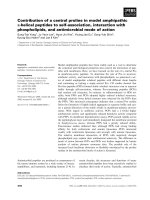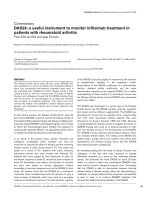Affective and instrumental commitment a special referece to self service technologies in domestic and foreign banks
Bạn đang xem bản rút gọn của tài liệu. Xem và tải ngay bản đầy đủ của tài liệu tại đây (721.42 KB, 85 trang )
UNIVERSITY OF ECONOMICS HO CHI MINH CITY
International School of Business
-------------------------------
Hoang Thi Bich Chi
AFFECTIVE AND INSTRUMENTAL COMMITMENT:
A SPECIAL REFERENCE TO SELF-SERVICE
TECHNOLOGIES IN DOMESTIC AND FOREIGN BANKS
MASTER OF BUSINESS (Honours)
Ho Chi Minh City- Year 2014
UNIVERSITY OF ECONOMICS HO CHI MINH CITY
International School of Business
-------------------------------
Hoang Thi Bich Chi
AFFECTIVE AND INSTRUMENTAL COMMITMENT:
A SPECIAL REFERENCE TO SELF-SERVICE
TECHNOLOGIES IN DOMESTIC AND FOREIGN BANKS
ID: 22120043
MASTER OF BUSINESS (Honours)
SUPERVISOR: Dr. LE NHAT HANH
Ho Chi Minh City- Year 2014
ACKNOWLEDGEMENT
Firstly, I would like to express my gratefulness to my supervisor Dr. Le Nhat Hanh
for her professional guidance, intensive support, valuable suggestions, instructions and
continuous encouragement during the time of research and writing this thesis.
I would like to express my deepest appreciation to ISB Research Committee for
their valuable time as their insightful comments and meaningful suggestions were
contributed significantly for my completion of this research.
My sincere thanks also go to all of all of my lecturers at International Business
School- University of Economics Ho Chi City for their teaching and guidance during my
Master course.
Last but not least, I would like to thanks my family, whom were always supporting
me and encouraging me with their best wishes.
ABSTRACT
The purpose of this research is to investigate the factors that influence customer
satisfaction and their commitment with self-service banking technologies. In particular,
this field study conducted in Vietnam focuses on making a comparison on customer
satisfaction and commitment of foreign banks and domestic banks with self-service
banking technologies. The research indicated perceived usefulness, perceived
convenience, privacy and security positive effect customer satisfaction. As result, such
positive effects lead to a significantly affective and instrumental commitment of customer
with banks in Vietnam. However, there are some differences between domestic banks and
foreign banks. Based on the findings presented, this study will provide bankers and policy
makers with a greater understanding of customer assessment to compose the appropriate
future strategies.
Key words: Self-service banking technologies, customer satisfaction, affective
commitment, instrumental commitment
TABLE OF CONTENTS
CHAPTER 1: INTRODUCTION ........................................................................................ 1
1.1 Research background ..................................................................................................... 1
1.2 Research gap .................................................................................................................. 3
1.3 Research objectives ....................................................................................................... 5
1.4 Research methodology and research scope ................................................................... 5
1.5 Research contribution .................................................................................................... 6
1.6 Research structure.......................................................................................................... 6
CHAPTER 2: LITERATURE REVIEW............................................................................. 8
2.1 Expectation-confirmation model in the context of IT (ECM-IT).................................. 8
2.2 Self-service banking technologies ................................................................................. 9
2.3 Customer satisfaction .................................................................................................... 9
2.4 Affective commitment ................................................................................................. 10
2.5 Instrumental commitment ............................................................................................ 11
2.6 Hypotheses development ............................................................................................. 12
2.6.1 Perceived usefulness .......................................................................................... 12
2.6.2 Perceived convenience ....................................................................................... 13
2.6.3 Security and privacy .......................................................................................... 14
2.6.4 Overview on customer satisfaction and commitment........................................ 15
2.7 The conceptual model and hypotheses of the research ............................................... 16
CHAPTER 3: RESEARCH METHODOLOGY ............................................................... 17
3.1 Research process.......................................................................................................... 17
3.2 Questionnaire design ................................................................................................... 18
3.3 Sample ......................................................................................................................... 21
3.4 Data collection ............................................................................................................. 21
3.5 Data analysis method ................................................................................................... 22
CHAPTER 4: DATA ANALYSIS .................................................................................... 23
4.1 Respondents’ demographics ........................................................................................ 23
4.2 Reliability Analysis ..................................................................................................... 25
4.3 Exploratory Factor Analysis (EFA)............................................................................. 30
4.3.1 EFA for independent variables ................................................................................. 30
4.3.2 EFA for Dependent variables ................................................................................... 32
4.4 Regression Analysis .................................................................................................... 33
4.4.1 Simple Regression analysis ............................................................................... 34
4.4.2 Multiple Regression Analysis ............................................................................ 38
CHAPTER 5: CONCLUSION, IMPLICATIONS, AND LIMITATIONS ...................... 47
5.1 Conclusion ................................................................................................................... 47
5.2 Managerial Implications .............................................................................................. 48
5.3 Limitations and future research ............................................................................ 50
REFERENCES .................................................................................................................. 52
APPENDICES ................................................................................................................... 64
LIST OF FIGURES
Figure 2.1: A theoretical model ......................................................................................... 16
Figure 3.1: Research Process ............................................................................................. 17
Figure D1: Histogram of Customer Satisfaction (Domestic/Foreign/Overall) ................. 76
Figure D2: Normal Plot of Customer satisfaction (Domestic/Foreign/Overall) ............... 77
Figure D3: Scatter Plot of Customer satisfaction (Domestic/Foreign/Overall) ................ 78
LIST OF TABLES
Table 3.1 Source of measurement scale ............................................................................ 18
Table 4.1 Respondent’s characteristics ............................................................................. 23
Table 4.2 Reliability test result .......................................................................................... 28
Table 4.3 KMO and Bartlett’s Test of Independent Variables.......................................... 30
Table 4.4 Rotated Component Matrix of Independent Variables ..................................... 31
Table 4.5 KMO and Bartlett’s Test of Independent Variables.......................................... 32
Table 4.6 Rotated component Matrix of Dependent variables .......................................... 32
Table 4.7 Model summary of simple regression analysis ................................................. 34
Table 4.8 ANOVA of simple regression analysis ............................................................. 35
Table 4.9 Coefficients of simple regression analysis ........................................................ 35
Table 4.10 Model summary of simple regression analysis ............................................... 36
Table 4.11 ANOVA of simple regression analysis ........................................................... 37
Table 4.12 Coefficients of simple regression analysis ...................................................... 37
Table 4.13 Correlations matrix .......................................................................................... 40
Table 4.14 Model summary of multiple regression analysis ............................................. 41
Table 4.15 ANOVA of multiple regression analysis ........................................................ 42
Table 4.16 Coefficients of multiple regression analysis ................................................... 42
Table 4.17 Summary of hypothesis testing result ............................................................. 45
1
CHAPTER 1: INTRODUCTION
This chapter presents the introduction to the study. It contains the research
background, research gap, research objective, research methodology, research scope,
contribution of research and research structure.
1.1 Research background
“Today fast-paced world is becoming increasingly characterized by technologyfacilitated transactions” (Meuter et al., 2000, p.50). Customers tend to interact with
technology to complete given task instead of interacting with a customer service
employee. According to Meuter et al., (2000) self-service technologies (SSTs) are
technological interfaces that allow customers to offer their own service independent of
interaction with a firm’s service personnel through the use of technology. SSTs represent
a variety of different services, ranging from the common automated teller machines
(ATMs), online book tickets, automated hotel checkout, banking by telephone. To
illustrate, most recently, a 24-hour ATM sells cupcakes on street in New York City,
America and Egold services which you can by gold via internet has just been launching
by TP Bank in Vietnam at the beginning of this year.
The rapid development of SSTs in recent years means that customers have changed
the way in which they deal with many services, including banking services (Bobbitt &
Dabholkar, 2001). Since the mid-1990s, there has been a fundamental change in banking
service channels toward using SSTs such as ATMs. These days, with the adoption of
technologically enhanced service delivery methods, an increasing number of financial
institutions are using technology in order to facilitate their services. A large and growing
number of consumers interact with these Self-service banking technologies (SSBTs) that
include online banking, ATMs, electronic funds transfer at the point of sale, mobile
banking, telephone banking, SMS banking, which are so prolific.
2
Affected by global economy crisis since 2008, economy of Vietnam has been
facing various challenges and the banking industry is not an exception. According to
General Statistics Office, a lot of companies have had to shut down in this year.
Therefore, the demand of loans and capital of those companies is shrunk resulting in the
reduction in the revenue of banking industry. To solve this problem, banks have to
develop their non-credit services in order to balance and diversify their sources of
revenue.
In addition, integration into WTO has also boosted Vietnamese economy to
develop remarkably. A significant amount of inflows of investment has been poured into
the market by foreign investors. Many foreign companies have taken part in different
industries including banking. The globalization of banking industry has encouraged many
developing countries including Vietnam into opening their markets to foreign banks and
built up the industry infrastructure to international standards. Those foreign banks own
various advantages in terms of not only capital and effective management system but also
high technology. The foreign banks perform better than domestic banks because of their
ownership advantages (Claessens, 2001; Harylchyk & Jurzyk, 2011). On the other hand,
due to the benefit of local market knowledge and longevity, domestic banks, especially
the state owned commercial banks dominate the market (Nahm, 2008). However, this
situation will change when the market opens freely. Therefore, to become more
competitive, domestic banks have to focus on improving their own service quality such as
professionalism of services provided and modernization in equipment and tools.
In today’s business environment, customers have become the center of all business
decisions right from the conception of product to the delivery of product. In the highly
competitive banking industry, service becomes one of the most important elements for
gaining a sustainable competitive advantage in the market place. Understanding the
potential impacts these SSBTs facilities may have on consumers’ satisfaction and their
ongoing commitment is the challenge for service managers and researchers.
3
Hence, it seems more and more important to determine the customer ongoing
commitment to the bank in this study.
In general, commitment is considered as the customers' retention, advocacy after
experiencing the quality, after self-service, shared value and trust of the vendor (Morgan
&Hunt, 1994). This implies that customer commitment to the service supplier would be of
vital importance to their loyalty in service industries, particularly in banking service.
Noticeably, commitment is a multidimensional construction which includes not only the
two afore mentioned components but also a wide range of others; and the effect of various
type of commitment on customer loyalty may not be equivalent in both magnitude and
direction (Fullerton, 2003). In marketing field, commitment is complicated and consists of
at least two following components: affective commitment and instrumental commitment
(Gundlach et al., 1995), which will be discussed in detail in current study. More
specifically, affective commitment is an attitudinal component which signalizes the
durable intention to thrive and maintain a permanent relationship in the long term;
instrumental commitment expresses an affirmative action taken by the vendor to make
customer interested in staying with them (Gundlach et al., 1995 as cited in Beatson, Coote
& Rudd, 2006). Nevertheless, in this study extent, affective commitment and instrumental
commitment are the two components discussed in more detail.
1.2 Research gap
The number of customers that are using SSBTs is increasing day by day. Vietnam
Banks Association (2014) stated that 40 banks have announced deployment of internet
banking system at different level. Especially, about using card services, as of 31th
December 2013, the total number of cards issued by 50 issuers of more than 66.2 million
cards- up more than 20% compared with 2012; total sales of more than 1,206,704 card
payment billion, up 23.37% compared with 2012. On infrastructure for payment card
transaction has installed approximately 15.300 ATMs and 130.000 POS (Vietnam Banks
Association, 2014).Vietnam is expected to share common characteristics such as huge
4
population. Moreover, according to eMarketer’s latest report as cited in Finance Journal
(2014), Vietnam has about 5.3 million internet subscribers, penetration rate reached
35.6%; and 121.7 million mobile subscribers, of which 30% are smart phones. These
notable figures are not only a good sign for the technology application industry, but also a
great opportunity for the development of SSBTs which is one of the key business
segments of banks today.
In the literature, there were a lot of researches about SSBTs (Pikkarainen et al.,
2004; Cheng et al., 2006; Guriting & Ndubisi, 2006; Farzianpour et al., 2014). From the
point of view, most of these study focus on determining the factors that directly affect
customer satisfaction, customer intention to use some basic kind of SSBTs and some
studies also briefly mentioned about their continued behavioral intention in generally.
Most of these studies on SSBTs in Vietnam have investigated popular SSBTs such as
ATMs, internet banking, mobile banking of a particular bank. Meanwhile, this research
will focus on finding about general SSBTs of banking system in Vietnam. To the best of
our knowledge, there were only few studies that have been conducted for examining the
effect of customer satisfaction on two specific dimensions of commitment (i.e., affective
and instrumental). In this study, by categorizing commitment into two components, the
investigation on the linkage between customer satisfaction and commitment becomes
clearer and more specific. SSBTs have been widely applied in developed countries,
however it is considered as an ongoing innovation in Vietnamese banks, and there are still
limited studies about SSBTs, customer satisfaction, and commitment in Vietnam. More
specifically, the research of Wang (2012) indicated that perceived convenience and
perceived usefulness of SSBTs have positive impact on customer satisfaction and their
commitment to the bank. Moreover, the research’s finding of Pikkarainen et al. (2004)
had showed that security and privacy impact significantly on customer satisfaction of
using SSBTs. Therefore, this research tries to test the effect of perceived convenience,
perceived usefulness and security and privacy of SSBTs on customer satisfaction and
their commitment to the banks.
5
In addition, the performance of foreign bank in Vietnam has been known a little
until now because of the lack of data and information, thus this study aims to examine
how domestic banks differ from foreign banks in the same market about customer
satisfaction and commitment with banks after using SSBTs.
1.3 Research objectives
The overall objective of this research is to examine some factors influencing
customer satisfaction and then affective and instrumental commitment, differences
between domestic banks and foreign banks about customer satisfaction and commitment,
particularly the following relationships are explored:
- The relationship between perceived convenience and consumer satisfaction with
SSBTs
- The relationship between perceived usefulness and consumer satisfaction with
SSBTs
- The relationship between security & privacy and consumer satisfaction with
SSBTs
- The relationship between consumer satisfaction and affective commitment with
banks
- The relationship between consumer satisfaction and instrumental commitment with
banks
1.4 Research methodology and research scope
The present study used questionnaire to collect data for an in depth investigation.
The structured unbiased questionnaire is originally conducted in English and then
translated into Vietnamese for survey. The questionnaire will be pre-tested on 10
respondents and minor modifications will be made to the questionnaire on the basis of
pre-testing. Data collected from survey will be descriptively analyzed by using Statistical
Package for the Social Science (SPSS) version 22.0. The analysis of data firstly will be
tested the reliability of the measurement scale by using Cronbach’s Alpha. After that, an
6
Exploratory Factor Analysis will be used to check the validity of the measurement scale.
Finally, single and multi linear regression will be employed as the main method for
investigating the relationships among factors in the research model. In consequently, this
result will be used for explaining the relationship among factors, and the analysis will also
describe the meaning of model when applying in Vietnam SSBTs.
Samples for the study based upon availability of respondents. The target
population of this study is customers who are using any kind of SSBTs of either domestic
or foreign banks in Vietnam.
1.5 Research contribution
The research investigates customer satisfaction and commitment in the case of
SSBTs in Vietnam. This study contributes to current and future research by comparing
and contrasting related literature. Especially, we hope to provide application to investigate
customer satisfaction and commitment with banks in Vietnam. The finding of this
research with clear understanding of customer satisfaction and commitment with bank in
using SSBTs can be served as a guideline for policymakers and leaders of banks in
Vietnam to satisfy their customer and maintain their commitment. In addition, it is also
necessary for the new coming banks, who want to join into this kind of modern service of
banking industry in Vietnam market.
1.6 Research structure
This research contains five chapters. The first chapter introduces an outline of this
study. It presents background of the research, researcher’s motivation and objective of
doing research. In addition, the introduction chapter also presents the practical
contributions as well as the methodology and scope of collecting data when doing this
research. Chapter two mainly introduces the theories in the literature related to each of
factors in the research model, including perceived usefulness, perceived convenience,
security & privacy, customer satisfaction, affective commitment and instrumental
commitment. The next chapter presents brief description of research methodology used
7
for the research. The results of data analysis will be discussed in chapter four. Finally,
chapter fine will summarize the main finding of research, and also mention about the
limitation of research.
8
CHAPTER 2: LITERATURE REVIEW
In this chapter, the theoretical framework related to the scope of this study will be
discussed in more details. This chapter will describe the research model and proposed
hypotheses. This review also explores the six factors related to the model and research
model of the study. The first parts of this review of literature will introduce the concept of
SSBTs.
2.1 Expectation-confirmation model in the context of IT (ECM-IT)
The proposed model of this study is based on Expectation-Confirmation Model in
the context of IT (ECM-IT) which provided a theoretical background for explaining
customer satisfaction with technology. Traditionally, customer satisfaction is explained
by the expectancy-confirmation paradigm (Oliver, 1993). Based on that, ExpectationConfirmation Model in the context of IT was developed by Bhattacherjee (2001) and has
been centered on the target online and mobile technology domain (Kang et al., 2009).
Bhattachcherjee (2001) argued that perceived usefulness is the most consistent antecedent
of individuals’ IT adoption intention, so it is proposed as a surrogate for post-usage
expectation in ECM-IT. Moreover, the hypothesized model extends the original ECM-IT
by adding two unique characters and important incentives in the SSBTs context including
perceived convenience and security & privacy.
In addition, another attempt of this study is to test the ways in which customer
satisfaction may impact on consequence behavior, such as customer commitment, which
has linked together in previous research (Garbarino & Johnson, 1999). This attention also
provides managers with insights into how to address customer satisfaction and
commitment with banks from a post-usage SSBTs expectation perspective.
Therefore, this study proposed and empirically validated the extended ECM-IT in
order to reflect the uniqueness of SSBTs.
9
2.2 Self-service banking technologies
“Self-service technologies (SSTs) are technological interfaces that enable
customers to produce a service independent of direct service employee involvement”
(Maeuter et al., 2000, p.50). SSTs has changing the way interaction between suppliers and
buyers, the customer can use these services by themselves, without any direct contact
with any employees of the firm (Eriksson & Nilsson, 2006). SSTs have been playing an
important role in enabling the way consumers perform service delivery themselves.
Therefore, using SSTs can bring a lot of benefits from the perspective of both the firm
and customers (Meuter et al., 2000).
The development of advanced SSTs set the standards for SSBTs. Most of financial
institutions has transformed from the traditional approach of brick-and-mortar into clickand-mortar (Ho & Ko, 2008). SSBTs represent a variety of different services, ranging
from the common automated teller machines (ATMs), online banking, mobile banking,
SMS banking, telephone banking, queue management systems.
2.3 Customer satisfaction
Customer satisfaction is one of the most important outcomes of marketing activity
(Spreng et al., 1996; Fournier & Mick, 1999). Customer satisfaction is known as an
“evaluation of the perceived discrepancy between prior expectations and the actual
performance of the product” (Tse & Wilton, 1988, p.204). Nowadays, in the dynamics
banking industry, customer satisfaction is considered as the essence of success. Customer
satisfaction day by day becomes very important for attracting more and more customers
for increasing customer base when doing business and also in banking sector. “Most of
the banks set their strategies towards increasing satisfaction and loyalty of customers
through the quality of service” (Siddiqi, 2011, p. 17). Customer satisfaction is considered
as a fully measure of service quality and which lead to the continuous behavior
relationships with the service supplier (Rust & Chung, 2006) as well as dominating SST
success (Chen et al., 2009). Prabhakaran (2003) stated that the customer is the king so the
10
higher customer satisfaction the higher commitment they are. According to Kumar et al.
(2009), high quality services reach high customer satisfaction and increases customer
loyalty or customer commitment as well. So understanding the determinants that lead to
the customer satisfaction are important for SSBTs success in retail banking.
2.4 Affective commitment
Customer satisfaction is manifested through their commitment to the providers.
Commitment can be defined as an aspiration to sustain the valued relationship between
customers and suppliers in the long term (Moorman et al., 1992). The more satisfied
consumers are with product or service received, the higher probability they commit to
maintain a stable long-term relationship with the organization (Heskett et al., 1994;
McQuitty, Finn & Wiley, 2000; Singh & Sirdeshmukh, 2000; Szymanski & Henard,
2001).
Affective commitment is one of fundamental components to the success of an
organization. It is considered as a psychological element of consumers when experiencing
the good quality of products or feeling satisfied with the services offered by the providers,
therefore, they themselves desire to continue the relationship with the organization
without any external force (Beatson, Coote & Rudd, 2006). If customers feel satisfied
with what they received from the SSTs such as perceived usefulness or convenience, they
volunteer to keep using the service without any exterior influence.
In order to build the customers' affective commitment toward a retail bank, there
are two exchanges taking place between the banker and the customer needed considering
carefully. Firstly, that is the exchanges of bank's products and services; moreover, it is
very requisite to dignify the role of usefulness, enjoyment and convenience that SSTs
brings to customers as well as the risk they have to face when using these services offered
by a bank. The other is an interaction between bankers and customers which Menon &
O'Connor (2007, p.162) called "interpersonal dimension". Reality shows the essential role
of interpersonal dimension of customers-bankers interaction in maintaining the affective
11
commitment, this role was mentioned in many previous research as well. Menon &
O'Connor (2007) suggested that while the core bank service is the main reason leading to
the interaction between customers and bankers, interpersonal interaction seems to be the
most vital element contributing to the customer satisfaction which ensures their affective
commitment.
In other words, in an accelerating pace of globalization and competitiveness,
customers' loyalty and desire of involving in an organization plays an important role in
the development and success of that corporation. The bank managers must take right
action to raise the effective commitment of customers through achieving a positive
answer from them to the question: "Do I want to maintain my membership in and
patronage of the co-operative?" (Jussila, Byrne & Tuominen, 2012, p.2).
2.5 Instrumental commitment
The second commitment dimension is instrumental commitment. In this type of
commitment, if consumers leave or do not want to continue using products or services of
an organization, they must incur perceived costs which can be economic or psychological
in nature, it means to be real or perceived (Morgan & Hunt, 1994 as cited in Beatson,
Coote & Rudd, 2006). Namely, the cost may be time or expenditure spent to find a new
employer with the same quality as the current one (Allen & Meyer, 1990 as cited in
Beatson, Lings & Gudergan, 2008) or irritation and risks when changing service providers
(Beaton et al, 2006). Therefore, when there is a perception of a lack of potential
alternative employer, customers tend to stay with their organization. However, Menon
and O'Connor (2007) suggested that if customers do not display good fit with company
offerings and the company cannot meet the needs of customers, but they do not
discontinue their membership due to perceived costs, the company should proactively
direct the customers to more suitable organization, this action reflects a concern for the
customers and may likely to bring a positive attitude from them to the company.
12
According to Hung et al. (2012) instrumental commitment based on a theory in
which an organization strived to convince its members to continue to involve by giving
them an inducement for contribution. Menon & O'Connor (2007) divided this inducement
into two types - extra-role social bonds and intra-role social bonds. The former can be an
event or workshop that makes providers and customers closer. The latter, for example,
providing customers with subscriptions to internal magazines, personal invitation to social
events. Customers will continue participate in the organization as long as the inducement
meet or exceed the benefit held by them. The more the spread between inducement and
contribution increases, the less the tendency of an individual to leave is (Penley & Gould,
1988 as cited in Hung et al., 2012) and vice versa.
2.6 Hypotheses development
2.6.1 Perceived usefulness
The importance of perceived usefulness has been widely recognized in the SSBTs.
Usefulness is the subjective probability that using the technology would improve the way
a person could finish their given task (Davis et al., 1989). Perceived usefulness is defined
as “the degree to which a person believes that using particular system would enhance his
or her job performance” (Davis, 1989, p.320). According to this definition, user context
will be more emphasized by asking customers to focus on perceived benefits, regardless
of the properties of the SSBTs themselves. Customers will not perceive SSBTs as useful
if they do not provide benefit. According to Guriting & Ndubisi (2006), perceived
usefulness is strongly associated with productivity. It suggests that using technology
would improve the way a user completes a given task. Perceived usefulness is the key
driver of consumer attitudes toward SSBTs usage. Many researchers (Gerrard &
Cunningham, 2003; Cheng et al., 2006) have found that perceived usefulness strongly
impact on customers’ intention to use any application. Perceived usefulness has been seen
as a primary motivator of SSBTs acceptance. In addition, perceived usefulness refers to
consumers’ perceptions regarding the outcome of the experience (Davis et al., 1992).
13
When SSTs meet customers’ needs, they are able to enjoy the benefits. Pikkarainen et al.
(2004) found perceived usefulness as a determinant of actual behavior which encouraged
the user of the twenty-first century banking to use more innovative and user friendly SSTs
that give them greater autonomy in performing banking transactions, in obtaining
information on financial advices, and in purchasing other financial products. So, if
consumers see the usefulness of SSBTs, they are more willing to use the SSBTs. Based
on above argument, the following hypothesis is developed:
Hypothesis 1: Perceived usefulness is positively related to customer satisfaction
2.6.2 Perceived convenience
Customer decision about whether to adopt the SSTs or not depend on many
factors, including convenience, risk, security and prior technological knowledge... Among
these elements, convenience seems to have the most significant impact on using or
rejecting SSTs, particularly perceived convenience. Even in the study of Eastin (2002), he
concluded that perceived convenience is the strongest predictor of SSTs usage.
Perceived convenience is defined as a degree to which a customer can use the
service whenever and wherever they need and it is clarified through an answer for the
question: "Is the service easy to access anywhere and anytime?" (Susanto & Goodwin,
2010, p.65).
In the banks’ perspective, perceived convenience is an element contributing to
fostering the quality of SSTs. Collier & Sherrel (2010) anticipated that perceived
convenience is a movement to force banker to improve and upgrade; thus, result in a
faster transaction for customers. If an ATM machine, which is contained in SSTs is
located in an inappropriate place or overcrowded environment that may prevent the
customers from fully interacting with the technology, these factors can lead to a reduction
in transaction speed because of the impact from outside. By reducing the time and effort
in looking for and facilitating the service transaction, perceived convenience contributes
to the quicker transaction for customers.
14
From the users’ point of view, perceived convenience influences their possibility
of discovery and raises their evaluation trust (Collier & Sherrel, 2010). Ahn et al. (2007)
asserted that the convenience of technology will heighten the willingness to explore
numerous feature offered by the technology instead of the strain to complete the
transaction as fast as possible. By offering customers more options on when and where to
enact a transaction, the banker implies the credibility and quality of their offering (Yang
et al., 2006). When customers perceived the convenience in finding and facilitating a selfservice transaction, the easiness in carrying out a transaction can reduce some of potential
risks, subsequently influenced the trust placed on the service bankers (Collier & Sherrel,
2010).
Being aware of the importance of perceived convenience, banking managers
should concentrate on this advantage factor in promoting SSTs (Susanto & Goodwin,
2010). Hence, we proposal the following hypothesis
Hypothesis 2: Perceived convenience is positively related to customer satisfaction
2.6.3 Security and privacy
The importance of security and privacy in banking services has been mentioned in
many researches (Hemandez & Mazzon, 2007; Chen & Barnes, 2007). The role of
security and privacy in the decision to adopt SSBTs is increased because customers
perform their transactions with no face-to-face contact with the supplier’s personnel and
no cash on hand. Customers are always concerned about potential financial risks and
threats for privacy and personal information lost (Yiu et al., 2007). The challenges in
terms of security and trust play the main role with using the public network to perform
transactions (Ganesan & Vivekanandan, 2009). Therefore bank should play their roles in
order to influence their customer’s perception of SSBTs security and privacy through
training and promotion strategies.
15
According to Maenpaa et al. (2008) security and privacy stands for the reliability
of an innovation and a belief on the part of the customer that most of banking transaction
can be completed confidentially and safely. The result of the study by Rogers, Gilbert &
Cabrera (1997) which surveyed eight none-users on their potential concerns about using
ATMs, indicated that safety was the most important. This result is almost similar to
Sathye (1999) study which also showed that privacy and security were found to be
significant obstacles to the acceptance of online banking in Australia. Thus, we can build
following conceptual hypothesis:
Hypothesis 3: Security and privacy is positively related to customer satisfaction
2.6.4 Overview on customer satisfaction and commitment
Customer satisfaction is a fundamental marketing concept (Fournier & Mick,
1999) and is defined as an affective state or overall emotional reaction to a service
experience (Giese & Cote, 2000). Moorman et al., defines commitment as “an enduring
desire to maintain a valued relationship” (1992, p. 316) and considers it as an essential
ingredient for successful long-term relationships (Morgan & Hunt, 1994). It is proposed
that customer commitment in this study is conceptualized as a multidimensional construct
with two dimensions: affective commitment and instrumental commitment, which have
been identified in previous research on commitment (Gundlach et al., 1995)
Customer satisfaction has linked with customer commitment (Garbarino &
Johnson, 1999) and generally considered as influential in the formation and development
of customer commitment (Johnson et al., 2008). Szymansky & Henard (2001) argue that
the more satisfied customers are with the service experience, the more likely they are to
commit to a relationship with the service supplier. And Bansal et al. (2004) also states
that customer satisfaction is a primary antecedent of affective commitment, the stronger
the customer satisfaction, the stronger the commitment in customer service. The previous
study has concluded that customer satisfaction have positive relationship with customer
16
commitment (Thurau, 2004). Based on previous research, the two following hypotheses
are developed:
Hypothesis 4: Customer satisfaction is positively related to affective commitment
And
Hypothesis 5: Customer satisfaction is positively related to instrumental
commitment.
2.7 The conceptual model and hypotheses of the research
Based on above literature reviews, the following model is proposed (see Figure 2.1)
Figure 2.1: A theoretical model
Perceived
Usefulness
Perceived
Convenienc
e
Affective
commitment
Consumer
satisfaction
Instrumental
commitment
Security
and Privacy
The hypotheses developed for this research include:
H1: Perceived usefulness is positively related to customer satisfaction
H2: Perceived convenience is positively related to customer satisfaction
H3: Security and privacy is positively related to customer satisfaction
H4: Customer satisfaction is positively related to affective commitment
H5: Customer satisfaction is positively related to instrumental commitment
17
CHAPTER 3: RESEARCH METHODOLOGY
This chapter presents brief description of research methodology used for the
research. At first, research process is present step by step. Then, it describes the
measurement scales which are used in designing and developing questionnaire. After that,
sample description is conducted, followed by data collection and data analysis method.
3.1 Research process
Figure indicates the progress and structure of this study.
Research gap
Research objective
Research contribution
LITERATURE REVIEW
Research model
& Hypotheses
Questionnaire
development
Draft scale
In-depth- interview_
Qualitative research
Final scale
DATA ANALYSIS
Reliability testing
(Cronbach’salpha)
Validity
testing
(EFA)
Conclusion and implication
Figure 3.1: Research Process
Hypothesis
testing
(Regression)









